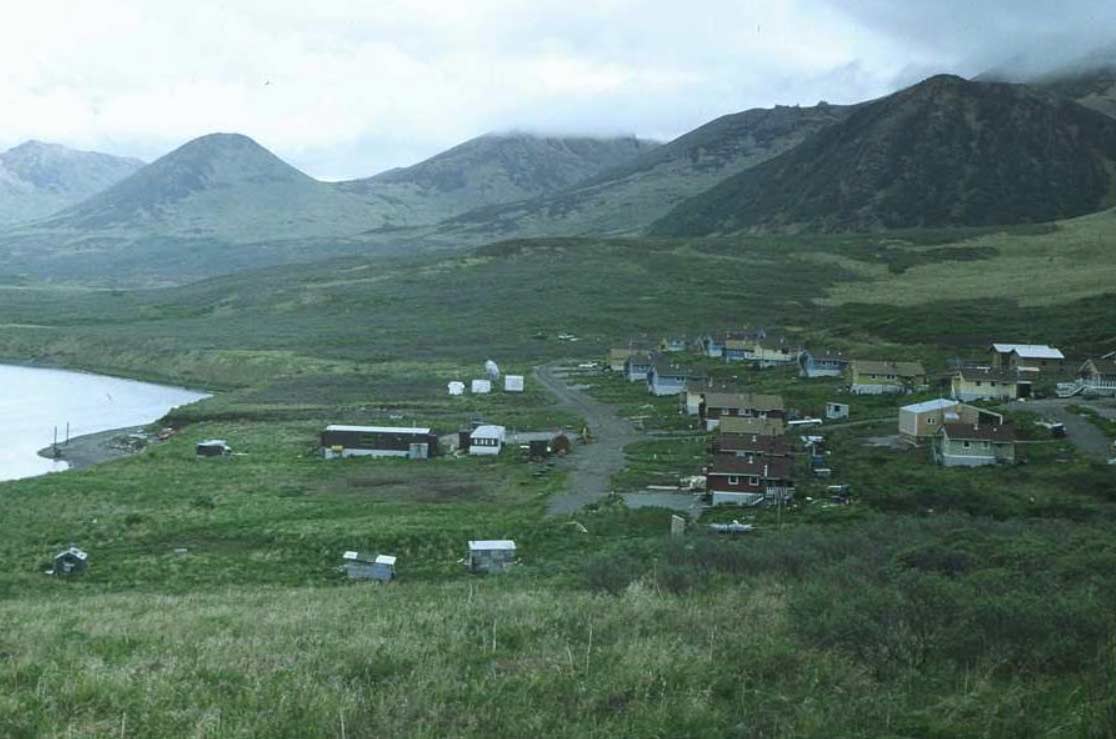

In 1983, I was a participant in the archaeological expedition at Karluk Village, located approximately 75 air miles southwest of the city of Kodiak. Surrounded by picturesque low-lying mountains and wet tundra, the mouth of the Karluk River and the Karluk Lagoon have been a homeland to the Alutiiq people for more than 5,000 years. A deeply stratified prehistoric archaeological site on the bank of the lagoon sits in close vicinity to the contemporary Alutiiq village and to the significantly aged Russian Orthodox Church on the top of hill overlooking the lagoon.
At the time, I was a PhD candidate at Bryn Mawr College, Pennsylvania. There were several trained and experienced archaeologists in the group, including Rick Knecht, Kevin Philbrook Smith, Glenn Sheen—then all PhD candidates at Bryn Mawr – and several enthusiastic volunteers. The expedition leader was the late Dr. Richard Jordan of Bryn Mawr College. None of us had extensive experience and expertise in this geographic area under investigation, only some theoretical background.
Between the contemporary village and archaeological site was a small wooden hut occupied by Lawrence Ponamoryoff, an Alutiiq in his early 60s. Lawrence and his wife resided in Los Angeles during the winter season. But in the summer, Lawrence would escape from California and find a sanctuary in Karluk, Alaska. He was connected spiritually and physically to his native land. Lawrence had a basic secondary school education, but his intelligence and wisdom were second to none. He thoroughly knew his Native land, and was an integral part of it. Lawrence kept repeating, “I am invigorating here when the salmonberries begin to ripen, and the red salmon are just about to swim up the river to spawn.”
Remnants of the rectangular prehistoric dwellings were the main archaeological features we excavated. Richard Jordan was convinced that these dwellings were above-ground Russian houses of the Russian American period in Alaska (1741 to 1867). Rick Knecht and I argued with Richard Jordan that those structures were, most likely, native Barabaras, but with no success. Aleutian Barabaras were the traditional homes of the Aleut and Alutiiq people of the Aleutian Islands. These communal dwellings were partially underground, like pit-houses.
In one of the intense arguments, Richard Jordan declared, “I am going to eat my shorts to prove that these are Russian dwellings.” Rick Knecht, with some degree of cautiousness, responded to Jordan’s declaration, “You better wash your shorts, before you eat them. These are not Russian dwellings.” Richard Jordan was our key Professor at Bryn Mawr; and I was impressed by Rick Knecht’s courageous response.
In my free time from digging, I enjoyed Lawrence’s company in his wooden hut. Lawrence was always a gracious host, treating me to a delicious smoked salmon and fish soup. I especially enjoyed his mysterious native stories. One day, I shared with Lawrence our intense arguments with Professor Jordan and our inability to persuade him to adopt a proper interpretation of archaeological and ethnohistoric data.

Lawrence listened attentively to my troubling concerns, then paused for a short moment and said: “I will tell you a story that I heard from my grandpa, the wise man.” I nodded my head in anticipation of the engaging story.
“One day a Bear and Ground Squirrel, Tsik Tsik for ground squirrel in our native language, had an argument over the color of grass. The Bear argued that grass is green, and Ground Squirrel argued that grass is blue. They argued and argued, but with no prevail. So, they decided to ask an old and wise Owl to resolve their dispute.
They approached an Owl and asked, ‘Bird of Wisdom, tell us whether the grass is green or blue? The Squirrel insists that it is blue, but I know for fact that it is green, not blue,’ insisted the Bear.
Owl slowly turned his head to the right then to the left and answered, ‘It is a blue color.’
Ground Squirrel happily hopped to his underground home, bragging, ‘I won, I won against a big Bear, the grass is blue!’
The Bear was puzzled by the Owl’s answer, ‘Why have you said that the grass is blue? You are perfectly aware that the grass is Green!’ roared the Bear angrily.
‘Yes, indeed, the grass is green,’ responded the Owl. But you wasted your time and efforts in trying to convince a stupid squirrel about something that is so obvious to all of us. You cannot rationalize someone who is brainwashed, irrationally stubborn and believe in the squirrel’s narrow-minded stupidity. Bear, go home,’ the Owl continued, ’believe in yourself, believe in your righteousness and always stand up for the factual truth and justice.’
That is all. And that’s the way I heard it,” concluded Lawrence.
ALASKA WATCHMAN DIRECT TO YOUR INBOX
The heated arguments between Professor Jordan and all crews of the Karluk expedition continued daily and brought a lot of stress to all of us. For me, the expedition in Karluk ended after three weeks and I moved to the Kenai Peninsula to excavate an archaeological site near the Russian River under the auspices of the Chugach National Forest Service. I also had a chance to visit the Russian Old Believers community of Nikolaevsk Village near Anchor Point, Kenai.
Today, there are so many moral parallels between Lawrence’s insightful story of the “Bear and Squirrel Argument” and the socio-political environment in our country. And, yet it is so unbearable to tolerate an extreme leftist’s beliefs, destroying our democratic Republic with its remarkable corruption, moral distortion and indoctrination of American youth, namely: White Privilege doctrine, Critical Race Theory, Systemic Racism, delusional transgender identity, neo-Marxism, violent anti-Semitic pro-Palestinian protests and rhetoric, and all other progressive nonsense.
I wonder, what learning and moral story the wise Alutiiq Lawrence could have for humanity today?
The views expressed here are those of the author.








8 Comments
So, were they Aleutian Barabaras or Russian Dwellings?? Paul Harvey’s “The Rest of the Story” is needed to complete the narrative.
Aleutian Barabaras
Great story! Something to think about.
8530@cnurban
And so it came to pass that Ground Squirrel found a warm, inviting home in the halls of government, became fruitful and multiplied, filled the country, and subdued it with their visions of Blue and all that shall be Blue henceforth.
.
Bear and Owl had to decide: watch in disbelief as Ground Squirrel’s descendants, once dismissed as brainwashed, irrationally stubborn, and narrow-mindedly stupid, overcome Bear’s strength and Owl’s wisdom, and turn everything Blue, or combine wisdom and strength to take their country back and turn Ground Squirrel Blue into a historical footnote.
.
Story’s not over. Denouement’s coming November 5… will strength, wisdom, and righteousness carry the day? will red, white, and blue be swallowed by Blue?
.
Stay tuned.
Praying for the red, white and blue victory! We are watching God Almighty’s timeline unfolding and learning many things. This nation needs to repent for its sins and ask for God Almighty to, once again, guide us.
Specifically what sins?
Thank you!